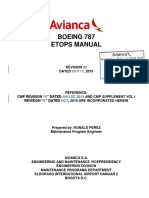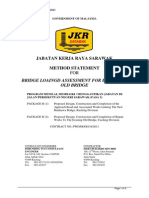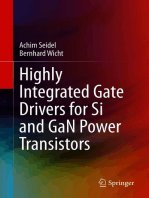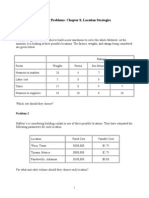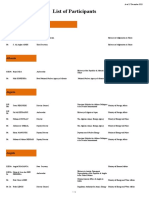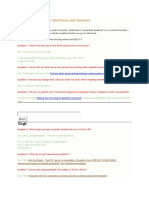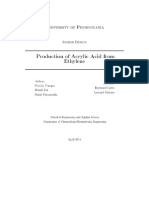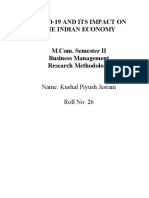Csibridge V23.1.0 Release Notes: Notice Date: 13-March-2021
Csibridge V23.1.0 Release Notes: Notice Date: 13-March-2021
Uploaded by
127blablaprCopyright:
Available Formats
Csibridge V23.1.0 Release Notes: Notice Date: 13-March-2021
Csibridge V23.1.0 Release Notes: Notice Date: 13-March-2021
Uploaded by
127blablaprOriginal Title
Copyright
Available Formats
Share this document
Did you find this document useful?
Is this content inappropriate?
Report this DocumentCopyright:
Available Formats
Csibridge V23.1.0 Release Notes: Notice Date: 13-March-2021
Csibridge V23.1.0 Release Notes: Notice Date: 13-March-2021
Uploaded by
127blablaprCopyright:
Available Formats
CSiBridge v23.1.
0 Release Notes
© 2021 Computers and Structures, Inc.
Notice Date: 13-March-2021
This document lists changes made to CSiBridge since v23.0.0, released 15-January-2021. Items marked
with an asterisk (*) in the first column are more significant.
API
Enhancements Implemented
* Ticket Description
5993 The utility that unregisters the Application Programming Interface (API) library types has
been enhanced. Previously, not all references to the API were removed from the Windows
Registry upon uninstallation of the software. This could cause difficulties using the API with
later versions of CSiBridge. Uninstalling the new version will now fully clean the registry of
references to the CSiBridge API.
6083 The CSiBridge API is now limited to start and/or connect to a running instance of CSiBridge
on a remote computer that is using a Network or Cloud license.
Bridge Modeler
Enhancements Implemented
* Ticket Description
5988 An enhancement has been implemented for the Advanced Concrete Box bridge section
definition in which the exterior girder angles now allow negative values greater than or
equal to -89 degrees. The legal range is now from -89 to +89 degrees. Previously the range
was from 0 to 89 degrees.
6003 The Bridge Modeler has been enhanced to improve the meshing of the slab for steel I-girder
bridges when the "Mesh Slab at Critical Steel I-Girder Location" option in the Update Bridge
Structural Model form is checked. Now two nearby slab mesh points created from the local
meshing of the slab due to section transitions in two adjacent non-prismatic girders will be
merged when either (1) the distance between the two points is within 2 inches (5 cm), or (2)
the distance between the two points is less than 10% of the distance between the two
global section cuts on either side of these two points. The new point location will be the
midpoint between the two merged slab points. Such merging reduces the number of
required edge constraints, and reduces the numerical sensitivity that can result from very
short edge constraints. In addition, for the case where similar merging is performed
manually by the user, definitions such as section cuts and generalized displacements that
reference the joint deleted in the merge are updated to reference the surviving joint of the
pair (this was not the case for previous versions).
6087 The Bridge Modeler has been enhanced to improve the sub-meshing of the beam (girder) in
the longitudinal direction to better match the sub-meshing of the slab for steel I-girder and
U-girder, precast concrete I-girder and U-girder, and Super-T bridge sections. As before,
longitudinal sub-meshing of the beam is also affected by the sub-mesh size specified for the
flange (if using full-shell modeling) and for the web (if using full-shell or mixed modeling).
Note that the sub-mesh size for the slab is specified when updating a bridge object, and it
has no effect when the value is larger than the specified segment length (the distance
between default global section cuts) except in the case of large skews or curvature. Spine
models of the bridge object are not affected by the sub-mesh size.
6179 An enhancement was implemented to improve the Super-T frame-section tendon layout by
1) allowing a second tendon to be defined at the top of each web, 2) allowing tendons in the
bottom of the section to be located closer to the edges, and 3) the default section now
contains one tendon at the top of each web.
CSiBridge v23.1.0 ISO #RELBRG2310 13-Mar-2021 Page 1 of 7
Installation and Licensing
Enhancements Implemented
* Ticket Description
* 5877 The version number has been changed to v23.1.0 for a new intermediate release.
Loading
Enhancements Implemented
* Ticket Description
* 4750 An enhancement has been implemented to add automated bridge wind loading according to
the IRC:6-2017 code.
6040 An enhancement has been implemented to add the Special Vehicle (SV), Fatigue Truck (40T),
and 70R Tracked Vehicle per the IRC:6-2017 code. The existing Class A, B, and 70R wheeled
vehicles were also updated to include edge distances and height to the center of gravity of
the load.
* 6041 An enhancement has been implemented to add bridge temperature-gradient loading
according to IRC:6-2017.
Results Display and Output
Enhancements Implemented
* Ticket Description
6065 An enhancement has been implemented for the design and rating of steel I-girder and steel
U-girder bridges where the haunch height (distance between the bottom of top flange and
soffit of top slab) is now reported in the design- and rating-results property tables.
CSiBridge v23.1.0 ISO #RELBRG2310 13-Mar-2021 Page 2 of 7
Analysis
Incidents Resolved
* Ticket Description
947 An incident was resolved where the acceleration loads generated for thin or thick shells with
joint offsets were inconsistent with the mass used for analysis. By way of explanation, mass
is always created at the joints. Previously, acceleration loads for shells were computed for
the mass at the mid-surface of the shell, then transformed to the joints, creating small
moment acceleration loads. This inconsistency between the location of the mass and the
associated acceleration load led to errors in the calculation of the participating-mass ratios.
It also could generate a warning message during Ritz-vector generation for acceleration
loads stating that loads were applied to massless degrees of freedom.
Now acceleration loads will be computed at the shell joints, consistent with the location of
the mass. Changes in results for acceleration loading and mass-participation factors can be
expected for models with shell joint offsets, limited by the size and associated mass of the
joint offsets relative to the overall dimensions and mass of the structure. Note that shell
joint offsets are common in models created by the Bridge Modeler, but these are generally
small and the effect on results will be minimal.
* 6021 An incident was resolved where, when a Parametric PMM hinge underwent a strain reversal
between points C and D of the backbone curve, the final strength of the hinge was fixed at
the level where the reversal occurred and did not drop further to the force/moment defined
for point E of the backbone curve. This issue affected both the steel and concrete type
Parametric PMM hinge, but did not affect other hinge types. This behavior was not common
because load reversal when losing strength is not common in most practical models.
* 6036 An incident was resolved where an analysis could inadvertently get canceled while
performing a license check. This issue was not common. It was timing-dependent and was
most likely to occur when running long, multi-stepped load cases. Running such load cases in
parallel and/or network connectivity issues that interfered with the license check increased
the prevalence. When the issue occurred, full results for completed load cases were
available, as well as partial results for load cases that were already running. No results were
available for load cases that had not started when the cancellation occurred.
* 6409 An incident was resolved where restraint-displacement loading applied in a nonlinear direct-
integration time-history load case using the Hilber-Hughes-Taylor (HHT) integration method
was being scaled by the factor one minus alpha (1 - α), where the HHT alpha value can range
from -1/3 ≤ α ≤ 0. The default and most common value is zero, corresponding to the
Newmark method, for which there was no error. In the worst case with α = -1/3, the applied
load could be 33% too large. Displacement loads applied through springs and one-joint link
elements were not affected, only loads applied through restraints. No other type of loading
was affected. No other type of load case was affected. In particular, FNA and linear direct-
integration load cases were not affected.
API
Incidents Resolved
* Ticket Description
* 6129 An incident was resolved in the Application Programming Interface (API) where following
changes broke compatibility with earlier API versions: (1) In CSiBridge v22.2.0 (CSiBridge.dll
version 1.9 and CSiAPIv1.dll version 1.9), the eMatTypeSteel_Chinese_Q345 enumeration
got renamed to eMatTypeSteel_Chinese_Q355. (a) Affected programs: CSiBridge v22.2.0,
v22.2.1, v23.0.0 (b) Affected API clients: (i) Compiled COM clients (e.g. VB6, Delphi) failed to
start. (ii) Interpreted COM clients (e.g. VBA) failed to compile/run if the affected
enumeration was used. (c) Fix: eMatTypeSteel_Chinese_Q345 enumeration got reinstated.
CSiBridge versions 22.2.0, 22.2.1, and 23.0.0 and corresponding CSiBridge.dll versions 1.9
and 1.13 & CSiAPIv1.dll versions between 1.9 and 1.13 should not be used for developing
plug-ins and/or API scripts to ensure full compatibility with past and future API versions. The
cOAPI.GetOAPIVersionNumber() method can be used to check for incompatible API versions
before using affected interfaces to prevent run-time errors.
CSiBridge v23.1.0 ISO #RELBRG2310 13-Mar-2021 Page 3 of 7
* Ticket Description
6420 An incident was resolved for the Application Programming Interface (API) where COM clients
sometimes could not launch or attach to instances of the software on a remote computer
running the CSiAPIService.exe. This was generally not a problem if the client first launched a
local instance of the software before attempting to work with a remote instance.
6439 An incident was resolved for the Application Programming Interface (API) where attaching to
a running instance of the software and executing methods to create a new template model
(e.g. New2DFrame, NewBlank) sometimes resulted in the application becoming non-
responsive.
Bridge Design and Rating
Incidents Resolved
* Ticket Description
6102 An incident was resolved in the procedure for calculating shear-only resistance for the JTG
3662 2018 Concrete Box Shear superstructure design request. Previously, the calculation
formulas for the shear-only option were the same as the torsion-only or shear and torsion.
Now the shear-only procedure follows JTG 3662 2018 article 5.2.9.
* 6112 An incident was resolved for the bridge design of Super-T bridge sections where the results
of the flexure design check were incorrect because the demand was calculated using
incorrect girder forces. In particular, the demand included forces from the tendons and the
tributary portion of the slab, but not from the Super-T girder itself. No other bridge-section
types were affected.
* 6174 An incident was resolved for bridge superstructure design per the AASHTO LRFD 2017 code
where the calculation of the torsional cracking moment Tcr for the Concrete Segmental
Shear Design check incorrectly used the AASHTO LRFD 2014 equation 5.8.2.1-4. This has now
been updated to use equation 5.7.2.1.-5 of the 2017 code.
Bridge Modeler
Incidents Resolved
* Ticket Description
5032 An incident was resolved where edits made in the steel beam editor were not applied and
maintained after updating the bridge model. The results corresponded to the data shown in
the steel beam editor form after updating the bridge model. This was corrected in v23.0.0,
but inadvertently omitted from the release notes.
6014 An incident was resolved for the Bridge Modeler where the bridge model could not be
generated when the bridge object contained a single-beam type of diaphragm that was
modeled as "mixed" (shell web and frame flanges) and the beam section was a steel
rectangular section. Now the steel rectangular section, the steel I section, and single-
segment non-prismatic sections containing either of these two steel sections can be
modeled as "mixed" when used in a single-beam diaphragm. Note that this only applies to
steel I-girder bridge sections when the I-girders themselves are modeled as mixed or full
shell, in other words, when the steel I-girder webs are modeled as shells.
6056 An incident has been resolved for Bridge Scheduler in which the rigid segments of a
segmental bridge object were not available for selection in the Object-Name drop-down list
on the form "Define/Edit Operations for Task" when the Object Type was "Segment".
6086 An incident was resolved for the Bridge Modeler where the sub-meshing specified for the
slab when updating a bridge object was not being applied to Super-T bridge sections except
for the first segment of the bridge object, i.e., between the first two global section cuts.
Results agreed with the model as generated. The effect of this was minor. No other bridge-
section types were affected.
6089 An incident was resolved for the Bridge Modeler where in which the name of a segmental
bridge traveler could not be changed in the Bridge Traveler Data form (command Bridge >
Erection > Traveler > Modify/Show). This problem could result in an incorrect traveler name
in the staged construction load cases generated by the segmental bridge scheduler
(command Bridge > Erection > Schedule Wizard > Generate Schedule).
CSiBridge v23.1.0 ISO #RELBRG2310 13-Mar-2021 Page 4 of 7
Database Tables
Incidents Resolved
* Ticket Description
5385 A minor correction was made to the database table names to match the corresponding
design code names: "Function - Response Spectrum - NZS 1170 2004" was changed to
"Function - Response Spectrum - NZS 1170.5-2016," and "Function - Response Spectrum -
JTGTB0201" was changed to "Function - Response Spectrum - JTGTB02-2013."
5956 An incident was resolved for importing the text data file (.B2K, .$BR) or modifying data using
the interactive database editor for a segmental bridge in which the operations "Set Traveler
for Segment" and "Remove Traveler" in the table "CASE - STATIC 6 - NONLINEAR STAGE
DATA" were not recognized. Note that the user might need to save the model file (.BDB)
from a previous version in order to correct this problem for subsequent export and import.
Note that the specialized definition of a segmental bridge object is not currently saved in the
database tables, and cannot be imported through the text or database-table files. However,
the bridge will be imported as a general bridge object, and any construction schedules or
staged-construction load-case definitions will be retained.
External Import and Export
Incidents Resolved
* Ticket Description
6295 An incident was resolved where importing a model text file (.$BR, .B2K) or database-table
file (Excel, Access) containing a bridge object with a bridge line load having a value of zero
was not allowed and would generate an error message. The rest of the model could be
imported and results agreed with the model as imported. Now, the bridge load definition
allows zero force and the import will accept a zero bridge load when importing.
Graphics
Incidents Resolved
* Ticket Description
6167 An incident was resolved where the top and bottom longitudinal stresses were switched in
the table obtained by clicking the "Show Table" button in the Bridge Response Display form
when plotting stresses for the following specific case: (1) For the entire bridge section with
the selected values "Longitudinal Stresses – Top and Bottom", (2) when plotting the
Max/Min values for an enveloping load case or combination, and (3) at stations where the
top stress was algebraically smaller (more negative) than the bottom stress. The values
plotted and tabulated are now determined as follows when plotting the Max/Min for
"Longitudinal Stresses – Top and Bottom": The reported top stress is either the maximum or
minimum value at each given station, whichever has the larger absolute value. Likewise, the
reported bottom stress is either the maximum or minimum value, whichever has the larger
absolute value at that station. To find the rage of stresses at either the top or bottom
location, plot the stress values for that single location rather than for the top and bottom
together.
Loading
Incidents Resolved
* Ticket Description
6080 An incident has been resolved where the tendon load defined in the Super-T frame section
tendon layout form was not saved when changed on the form. The tendon load applied to
the model would remain the default and was reflected in the tendon object details via right-
click and the database tables.
* 6265 An incident was resolved where the wind loads generated for bridge superstructures would
be zero for the CAN/CSA S6 and Eurocode codes if the wind load pattern contained only
vertical load. Horizontal and vertical wind loads were correctly generated if the load pattern
specified any horizontal loading.
CSiBridge v23.1.0 ISO #RELBRG2310 13-Mar-2021 Page 5 of 7
* Ticket Description
* 6453 An incident was resolved for bridge wind on live load according to Eurocode and the CSA S6-
14 code. Previously the height of the surface area used for wind on live load was being taken
as a unit height instead of the height specified in the respective loading code, therefore
underestimating the load. A height of 2m is now considered for Eurocode. A height of 3m
minus the barrier height is now taken for the CSA S6-14 code.
Results Display and Output
Incidents Resolved
* Ticket Description
6141 An incident was resolved where, when linear-type links with non-zero damping coefficients
were used in a nonlinear modal time-history (FNA) load case, the link viscous damping
energy for these links was incorrect reported as being zero. When this issue occurred, the
missing linear-link viscous damping energy would be included in the energy error, so that
the total energy and other energy components were not affected. No other results were
affected. Only CSiBridge v23.0.0 was affected.
6150 An incident was resolved where the plotted DC ratio for positive moment for the AASHTO
LRFD service design check of steel I-girder bridges was incorrect, and was actually displaying
the depth of the web in compression for the elastic range. This was a plotting error and did
not affect the design check results. The values of the DC ratio for positive moment
presented in tables and reports were correct. Only the plotted results shown using the
commands Display > Show Bridge Superstructure Design Results (or Show Bridge
Superstructure Forces/Stresses > Design) were affected.
Section Designer
Incidents Resolved
* Ticket Description
6266 An incident was resolved where assigning ASCE 41-17 concrete column hinges to columns
with Section Designer sections would cause an error condition.
Structural Model
Incidents Resolved
* Ticket Description
* 6422 An incident was resolved where the steel and rebar uniaxial stress-strain curves were using
minimum instead of expected strengths. Nonlinear results for models run in the new version
that use these stress-strain curves, such as models with fiber hinges and/or directional
materials in layered shells, can be expected to produce changed results consistent with an
increase in the strengths. Materials with user-defined stress-strain curves are not affected.
User Interface
Incidents Resolved
* Ticket Description
5371 An incident was resolved where the units conversion used to display shear and direct force
parameters for partial fixity area edge releases in the Object Model - Area Information form
which is accessed by right-clicking on an area object was not correct when the display units
were different from the database units. This was a display issue only. The correct value was
displayed in the tables and was used in analysis.
6151 An incident was resolved where the temperature loads on the bridge section data form were
not converted when the units on the form were changed between Fahrenheit and Celsius.
The numerical values present, along with the units selected on the form when OK was
clicked would define what values were saved and used for analysis. Now the values are
converted when changing the selected units on the form.
CSiBridge v23.1.0 ISO #RELBRG2310 13-Mar-2021 Page 6 of 7
* Ticket Description
* 6155 An incident has been resolved where, for the forms defining bridge design requests for the
steel I-girder and steel U-girder strength/ultimate design checks, it was possible to delete
the two required demand sets Mdnc and Mdc. Now when either of these two rows are
selected, the Delete button will be disabled. Previously, deleting either of these two demand
sets could cause the software to terminate abnormally. The presence of at least one other
demand set will now also be enforced.
CSiBridge v23.1.0 ISO #RELBRG2310 13-Mar-2021 Page 7 of 7
You might also like
- Hydrocyclone Process Simulation Using Aspen HYSYSDocument8 pagesHydrocyclone Process Simulation Using Aspen HYSYSmadhav287No ratings yet
- Etops Apu 787 PDFDocument49 pagesEtops Apu 787 PDFCesar Roberto Amorocho AlvarezNo ratings yet
- WLC1 Q1Document7 pagesWLC1 Q1SeyahatNo ratings yet
- Automated Broad and Narrow Band Impedance Matching for RF and Microwave CircuitsFrom EverandAutomated Broad and Narrow Band Impedance Matching for RF and Microwave CircuitsNo ratings yet
- Reinforced Concrete Buildings: Behavior and DesignFrom EverandReinforced Concrete Buildings: Behavior and DesignRating: 5 out of 5 stars5/5 (1)
- List of UAE Educational InstitutionsDocument4 pagesList of UAE Educational InstitutionsManthan Bhanushali100% (1)
- Caltex Filipino Managers and Supervisors Association vs. CirDocument1 pageCaltex Filipino Managers and Supervisors Association vs. CirAnn Catalan100% (2)
- Release Notes Csi Bridge V 2100Document10 pagesRelease Notes Csi Bridge V 2100thekrauser96No ratings yet
- Release Notes Csi Bridge 2016 V 1820Document16 pagesRelease Notes Csi Bridge 2016 V 1820Ihab El AghouryNo ratings yet
- Release Notes Csi Bridge V 2210Document10 pagesRelease Notes Csi Bridge V 2210hichem titouNo ratings yet
- Csibridge Release Notes: Notice Date: 2019-08-21Document13 pagesCsibridge Release Notes: Notice Date: 2019-08-21Ali younsiNo ratings yet
- Release Notes Sap 2000 V 2320Document6 pagesRelease Notes Sap 2000 V 2320hichem titouNo ratings yet
- Notice Date: 10-January-2022: ETABS v20.0.0 Release NotesDocument25 pagesNotice Date: 10-January-2022: ETABS v20.0.0 Release NotesGifari ZulkarnaenNo ratings yet
- Release NotesDocument4 pagesRelease NotesasdNo ratings yet
- Release Notes SAP2000 V 2200Document6 pagesRelease Notes SAP2000 V 2200padeepNo ratings yet
- ReleaseNotes PDFDocument6 pagesReleaseNotes PDFla_civilNo ratings yet
- Release Notes SAP2000 V 2520Document9 pagesRelease Notes SAP2000 V 2520Ravi SehgalNo ratings yet
- Release Notes ETABS v2200Document13 pagesRelease Notes ETABS v2200Ali RizgarNo ratings yet
- Notice Date: 29-March-2021: ETABS v19.1.0 Release NotesDocument11 pagesNotice Date: 29-March-2021: ETABS v19.1.0 Release Notesalejandro mantillaNo ratings yet
- Release Notes Sap 2000 V 2300Document6 pagesRelease Notes Sap 2000 V 2300arya triartaNo ratings yet
- Release Not Ese Tabs 2015 V 1510Document7 pagesRelease Not Ese Tabs 2015 V 1510jwanroNo ratings yet
- RAPT Release NotesDocument25 pagesRAPT Release NotesSteve TaylorNo ratings yet
- Release Notes SAFEv 2010Document6 pagesRelease Notes SAFEv 2010kheang amgNo ratings yet
- Release Notes Sap 2000 V 1811Document10 pagesRelease Notes Sap 2000 V 1811ChiaChing HsiaoNo ratings yet
- ReleaseNotes PDFDocument21 pagesReleaseNotes PDFFrancisco Jose Arista QuinteroNo ratings yet
- 2006 Bridge Pircher PDFDocument10 pages2006 Bridge Pircher PDFReenu VermaNo ratings yet
- Release Notes Csi Bridge 2017 V 1900Document9 pagesRelease Notes Csi Bridge 2017 V 1900Ihab El AghouryNo ratings yet
- Etabs Release Notes: Notice Date: 2019-06-12Document29 pagesEtabs Release Notes: Notice Date: 2019-06-12johnNo ratings yet
- ReleaseNotes PDFDocument10 pagesReleaseNotes PDFJohn Franklin Ramos MamaniNo ratings yet
- Release Notes SAFEv 2200Document4 pagesRelease Notes SAFEv 2200HarryNo ratings yet
- Release Notes SAP2000 V 2410Document14 pagesRelease Notes SAP2000 V 2410beesyah14No ratings yet
- ReleasenotesDocument35 pagesReleasenotesdenise_rosales_1No ratings yet
- RM Bridge CONNECT Edition V11 Update 8 Release Notes (May 2020)Document21 pagesRM Bridge CONNECT Edition V11 Update 8 Release Notes (May 2020)Ave Robin M. RamosNo ratings yet
- Release Not Ese Tabs 2016 V 1600Document21 pagesRelease Not Ese Tabs 2016 V 1600Ahmad FuqahaNo ratings yet
- SAP2000 Release Notes: Notice Date: 2017-03-10Document9 pagesSAP2000 Release Notes: Notice Date: 2017-03-10Arturo Tipacti QuijanoNo ratings yet
- SAP2000 Release Notes: Notice Date: 2014-01-24Document6 pagesSAP2000 Release Notes: Notice Date: 2014-01-24Nicolas Fuentes Von KieslingNo ratings yet
- Release Not Ese Tabs V 1801Document31 pagesRelease Not Ese Tabs V 1801BMSF khaliqeNo ratings yet
- Release Notes Safe V 2000Document10 pagesRelease Notes Safe V 2000BANAT OGLUNo ratings yet
- Lecture 8.4.2 Plate Girder Behaviour and Design IIDocument9 pagesLecture 8.4.2 Plate Girder Behaviour and Design IIing_fernandogalvez2015No ratings yet
- Release Notes Sap 2000 V 1911Document10 pagesRelease Notes Sap 2000 V 1911TarmanNo ratings yet
- Etabs Release Notes: Notice Date: 2014-06-12Document9 pagesEtabs Release Notes: Notice Date: 2014-06-12Domino BlackNo ratings yet
- Al Nakheel Avenue Mall - CommentsDocument4 pagesAl Nakheel Avenue Mall - Commentsdilip kumarNo ratings yet
- Release NotesDocument44 pagesRelease Notessam khanNo ratings yet
- Full Scale Load Test For BridgeDocument9 pagesFull Scale Load Test For BridgeAlsonChin0% (1)
- Release Notes CSi Plantv 710 Plus 700Document12 pagesRelease Notes CSi Plantv 710 Plus 700velap15504No ratings yet
- ACOBRIDocument153 pagesACOBRISima ViorelNo ratings yet
- Release Notes For RISA-3D: Version 11.0.1 Enhancements/CorrectionsDocument24 pagesRelease Notes For RISA-3D: Version 11.0.1 Enhancements/CorrectionsjjirwinNo ratings yet
- Release Notes C Six Cad V 1900Document5 pagesRelease Notes C Six Cad V 1900hichem titouNo ratings yet
- Cau 2014Document25 pagesCau 2014vinay1999No ratings yet
- Release Notes SAP2000 V 2530Document6 pagesRelease Notes SAP2000 V 2530Mario Francisco Soto PáezNo ratings yet
- Release NotesDocument56 pagesRelease NotesRiki AnfalNo ratings yet
- 2019 ATUG Tower WhatsNewDocument9 pages2019 ATUG Tower WhatsNewMehdi TrabelsiNo ratings yet
- INDOT Practice Pointers 1-14-15Document4 pagesINDOT Practice Pointers 1-14-15Mike2322No ratings yet
- Release Notes Sap 2000 V 2110Document11 pagesRelease Notes Sap 2000 V 2110thekrauser96No ratings yet
- Cable Stayed BackwardDocument69 pagesCable Stayed BackwardIonut FalcescuNo ratings yet
- ETABS Version 9.2.0 Release NotesDocument16 pagesETABS Version 9.2.0 Release NotesJose Ramon MarcanoNo ratings yet
- Articulated Concrete Block DesignDocument8 pagesArticulated Concrete Block DesignRashid MinhajNo ratings yet
- 2 Cable Stayed Backward PDFDocument69 pages2 Cable Stayed Backward PDFHafiz DoyoxNo ratings yet
- PSC I-Girder Bridge Design in AASHTO-LRFDDocument99 pagesPSC I-Girder Bridge Design in AASHTO-LRFDSANDIPNo ratings yet
- Shear Wall Verification - ACI 318-08 (RAM Concrete) - RAM - STAAD Wiki - RAM - STAAD - Bentley CommunitiesDocument10 pagesShear Wall Verification - ACI 318-08 (RAM Concrete) - RAM - STAAD Wiki - RAM - STAAD - Bentley CommunitiesRajed MaglinteNo ratings yet
- Bridge-Ch-5-Box-Girder DesignDocument7 pagesBridge-Ch-5-Box-Girder DesignAbera Mamo JaletaNo ratings yet
- Design and Test Strategies for 2D/3D Integration for NoC-based Multicore ArchitecturesFrom EverandDesign and Test Strategies for 2D/3D Integration for NoC-based Multicore ArchitecturesNo ratings yet
- Highly Integrated Gate Drivers for Si and GaN Power TransistorsFrom EverandHighly Integrated Gate Drivers for Si and GaN Power TransistorsNo ratings yet
- Design for High Performance, Low Power, and Reliable 3D Integrated CircuitsFrom EverandDesign for High Performance, Low Power, and Reliable 3D Integrated CircuitsNo ratings yet
- Wind Loads On Double Skillion Roof HousesDocument12 pagesWind Loads On Double Skillion Roof Houses127blablaprNo ratings yet
- Stanford R - Sourish Banerjee - RedactedDocument147 pagesStanford R - Sourish Banerjee - Redacted127blablaprNo ratings yet
- TS REL 2021 en Tekla Structures 2021 Release NotesDocument137 pagesTS REL 2021 en Tekla Structures 2021 Release Notes127blablaprNo ratings yet
- Wind Modelling NIWA-min-compressedDocument38 pagesWind Modelling NIWA-min-compressed127blablaprNo ratings yet
- Release Notes IDEA StatiCa 21Document34 pagesRelease Notes IDEA StatiCa 21127blablaprNo ratings yet
- Strengthening Prestressed Beams Using Parafil Ropes As External TendonsDocument277 pagesStrengthening Prestressed Beams Using Parafil Ropes As External Tendons127blablaprNo ratings yet
- Emma 557 12 2Document16 pagesEmma 557 12 2127blablaprNo ratings yet
- CM02 Concrete Masonry - Single-Leaf Masonry Design ManualDocument28 pagesCM02 Concrete Masonry - Single-Leaf Masonry Design Manual127blablaprNo ratings yet
- Practice Problems: Chapter 8, Location Strategies: Problem 1Document9 pagesPractice Problems: Chapter 8, Location Strategies: Problem 1Jose Fabian MatamorosNo ratings yet
- Fundamentals of StatisticsDocument23 pagesFundamentals of StatisticsJell Vicor Opena100% (1)
- Morgan Grossnickle - School Counselor - Asca - The Role of The School CounselorDocument2 pagesMorgan Grossnickle - School Counselor - Asca - The Role of The School Counselorapi-508696161100% (1)
- 2017-18 Microwave Engineering 6th SemDocument2 pages2017-18 Microwave Engineering 6th SemPulkit GoelNo ratings yet
- Foundation Design 8 PDF FreeDocument108 pagesFoundation Design 8 PDF FreevictorNo ratings yet
- Participants - Fukushima Ministerial Conference On Nuclear SafetyDocument42 pagesParticipants - Fukushima Ministerial Conference On Nuclear SafetyAhmed AwaiseNo ratings yet
- Powershell Interview Questions and Answers: Find Out Which Server and Services Are Running Under A Specific AccountDocument4 pagesPowershell Interview Questions and Answers: Find Out Which Server and Services Are Running Under A Specific AccountCyb3rAlienNo ratings yet
- 12 Chapter3Document25 pages12 Chapter3Kajal GoswamiNo ratings yet
- Cyber Bullying PowerpointDocument2 pagesCyber Bullying PowerpointAbdullatif AbdullaNo ratings yet
- Astm D523Document5 pagesAstm D523CEMRE YAŞLINo ratings yet
- Power Hour Research INDUSTRY K-HudsDocument16 pagesPower Hour Research INDUSTRY K-HudsJorge Robledo MorenoNo ratings yet
- SMI Catalogue 2015Document109 pagesSMI Catalogue 2015MOHSENNo ratings yet
- Rpp165 InstructionsDocument16 pagesRpp165 InstructionswmjgoffNo ratings yet
- ISSE Midwest 2012 Preshow BrochureDocument52 pagesISSE Midwest 2012 Preshow BrochureprobeautyassociationNo ratings yet
- International Banking and Foreign Exchange Management JUNE 2022Document12 pagesInternational Banking and Foreign Exchange Management JUNE 2022Rajni KumariNo ratings yet
- Production of Acrylic Acid From EthyleneDocument259 pagesProduction of Acrylic Acid From EthyleneJuliaPirruia100% (2)
- CELESPARA, Joey D. Complaint and Counter AffidavitDocument6 pagesCELESPARA, Joey D. Complaint and Counter Affidavitjoey celesparaNo ratings yet
- SDS Yellow Petroleum Jelly Ex SonnebornDocument10 pagesSDS Yellow Petroleum Jelly Ex SonnebornAFI FARMANo ratings yet
- Practices of Crop Production: Laboratory Exercise No. 1: Farm Tools, Equipment and Implements For Land PreparationDocument9 pagesPractices of Crop Production: Laboratory Exercise No. 1: Farm Tools, Equipment and Implements For Land PreparationRoxan Mae Amplayo100% (1)
- Stage2 Cse 116 AlphonceDocument4 pagesStage2 Cse 116 AlphonceNuckMyFuts352No ratings yet
- Concepts KubernetesDocument642 pagesConcepts Kubernetesjustin jazzNo ratings yet
- Bio JohnsonDocument2 pagesBio Johnsonapi-298565705No ratings yet
- IYOBEDocument4 pagesIYOBEAnnjelyn Hazel FabayNo ratings yet
- Kushal Jesrani 26 Research MethodologyDocument70 pagesKushal Jesrani 26 Research MethodologyKushal JesraniNo ratings yet
- Libi vs. IACDocument14 pagesLibi vs. IACjNo ratings yet
- As Per MOHS Regulations: Lations of The Canada Labour Code Requires, in Part, The FollowingDocument2 pagesAs Per MOHS Regulations: Lations of The Canada Labour Code Requires, in Part, The FollowingmounNo ratings yet

